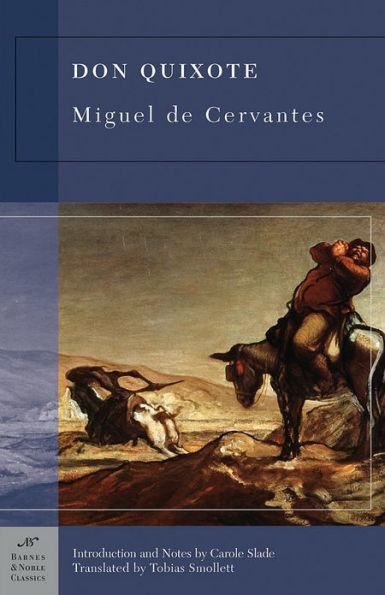Peter Orner has some dangerous habits — like reading at traffic lights. He talks with Mark Athitakis about the life of an unusually enthusiastic reader and his new book “Am I Alone Here”?
Don Quixote, by Miguel de Cervantes, is part of the Barnes & Noble Classics series, which offers quality editions at affordable prices to the student and the general reader, including new scholarship, thoughtful design, and pages of carefully crafted extras. Here are some of the remarkable features of Barnes & Noble Classics:
- New introductions commissioned from today's top writers and scholars
- Biographies of the authors
- Chronologies of contemporary historical, biographical, and cultural events
- Footnotes and endnotes
- Selective discussions of imitations, parodies, poems, books, plays, paintings, operas, statuary, and films inspired by the work
- Comments by other famous authors
- Study questions to challenge the reader's viewpoints and expectations
- Bibliographies for further reading
- Indices & Glossaries, when appropriate
Widely acknowledged as the first modern novel, Miguel de Cervantes’s Don Quixote features two of the most famous characters ever created: Don Quixote, the tall, bewildered, and half-crazy knight, and Sancho Panza, his rotund and incorrigibly loyal squire. The comic and unforgettable dynamic between these two legendary figures has served as the blueprint for countless novels written since Cervantes’s time.
An immediate success when first published in 1604, Don Quixote tells the story of a middle-aged Spanish gentleman who, obsessed with the chivalrous ideals found in romantic books, decides to take up his lance and sword to defend the helpless and destroy the wicked. Seated upon his lean nag of a horse, and accompanied by the pragmatic Sancho Panza, Don Quixote rides the roads of Spain seeking glory and grand adventure. Along the way the duo meet a dazzling assortment of characters whose diverse beliefs and perspectives reveal how reality and imagination are frequently indistinguishable.
Profound, powerful, and hilarious, Don Quixote continues to capture the imaginations of audiences all over the world.
Features illustrations by Gustave Doré.
Carole Slade specializes in late medieval and early modern European literature.Her publications include St. Teresa of Avila: Author of a Heroic Life and Approaches to Teaching Dante’s “Divine Comedy”. She teaches Comparative Literature at Columbia University.
Don Quixote, by Miguel de Cervantes, is part of the Barnes & Noble Classics series, which offers quality editions at affordable prices to the student and the general reader, including new scholarship, thoughtful design, and pages of carefully crafted extras. Here are some of the remarkable features of Barnes & Noble Classics:
- New introductions commissioned from today's top writers and scholars
- Biographies of the authors
- Chronologies of contemporary historical, biographical, and cultural events
- Footnotes and endnotes
- Selective discussions of imitations, parodies, poems, books, plays, paintings, operas, statuary, and films inspired by the work
- Comments by other famous authors
- Study questions to challenge the reader's viewpoints and expectations
- Bibliographies for further reading
- Indices & Glossaries, when appropriate
Widely acknowledged as the first modern novel, Miguel de Cervantes’s Don Quixote features two of the most famous characters ever created: Don Quixote, the tall, bewildered, and half-crazy knight, and Sancho Panza, his rotund and incorrigibly loyal squire. The comic and unforgettable dynamic between these two legendary figures has served as the blueprint for countless novels written since Cervantes’s time.
An immediate success when first published in 1604, Don Quixote tells the story of a middle-aged Spanish gentleman who, obsessed with the chivalrous ideals found in romantic books, decides to take up his lance and sword to defend the helpless and destroy the wicked. Seated upon his lean nag of a horse, and accompanied by the pragmatic Sancho Panza, Don Quixote rides the roads of Spain seeking glory and grand adventure. Along the way the duo meet a dazzling assortment of characters whose diverse beliefs and perspectives reveal how reality and imagination are frequently indistinguishable.
Profound, powerful, and hilarious, Don Quixote continues to capture the imaginations of audiences all over the world.
Features illustrations by Gustave Doré.
Carole Slade specializes in late medieval and early modern European literature.Her publications include St. Teresa of Avila: Author of a Heroic Life and Approaches to Teaching Dante’s “Divine Comedy”. She teaches Comparative Literature at Columbia University.

Don Quixote (Barnes & Noble Classics Series)
928
Don Quixote (Barnes & Noble Classics Series)
928eBook
Related collections and offers

Product Details
| ISBN-13: | 9781411432086 |
|---|---|
| Publisher: | Barnes & Noble |
| Publication date: | 06/01/2009 |
| Series: | Barnes & Noble Classics Series |
| Sold by: | Barnes & Noble |
| Format: | eBook |
| Pages: | 928 |
| Sales rank: | 17,407 |
| File size: | 31 MB |
| Note: | This product may take a few minutes to download. |
| Age Range: | 3 Months to 18 Years |
About the Author
Customer Reviews
Explore More Items
George Babbitt is a forty-six-year-old real estate broker. His job allows him to enjoy many commodities of the middle-class, and offers he and his family a place in an elevated social circle. With
Mr. and Mrs. Seth Appleby were almost old. They called each other
"Father" and "Mother." But frequently they were guilty of holding hands,
or of cuddling together in corners, and Father was a
The Sisters
An Encounter
Araby
Eveline
After the Race
Two Gallants
The Boarding House
A Little Cloud
Counterparts
Clay
A Painful Case
Ivy Day
